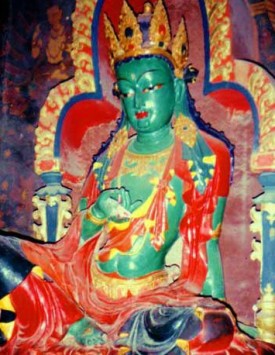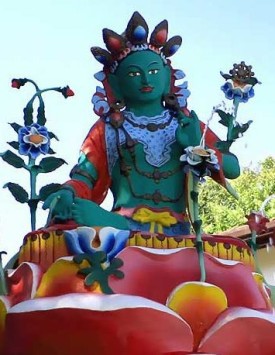Green Tara is one of the many ancient buddhas who can help living beings on their evolutionary journey to buddhahood. She is also known as the Savioress for her work in helping those in trouble or in need. It is said that she came into being from the tears of Avalokiteshvara (Kuan Yin) Bodhisattva who wept out of compassion for the suffering of living beings and their unwillingness to let go of that which caused their suffering.
Green Tara is usually associated with protection from fear and the following eight obscurations: lions (pride), wild elephants (delusion/ignorance), fires (hatred and anger), snakes (jealousy), bandits and thieves (wrong views, including fanatical views), bondage (avarice and miserliness), floods (desire and attachment), and evil spirits and demons (deluded doubts).
The following story is told of the origins of Tara: “There is a young princess who lives in a different world system, millions of years in the past. Her name is Yeshe Dawa, which means “Moon of Primordial Awareness”. For quite a number of aeons she makes offerings to the Buddha of that world system, whose name was Tonyo Drupa. She receives special instruction from him concerning bodhicitta—the heart-mind of a bodhisattva. After doing this, some monks approach her and suggest that because of her level of attainment she should next pray to be reborn as a male to progress further. At this point she lets the monks know in no uncertain terms that from the point of view of Enlightenment it is only “weak minded worldlings” who see gender as a barrier to attaining enlightenment. She sadly notes there have been few who wish to work for the welfare of beings in a female form, though. Therefore, she resolves to always be reborn as a female bodhisattva, until samsara is no more. She then stays in a palace in a state of meditation for some ten million years, and the power of this practice releases tens of millions of beings from suffering. As a result of this, Tonyo Drupa tells her she will henceforth manifest supreme bodhi as the Goddess Tārā in many world systems to come.”
H.H. the Dalai Lama said the following about Tārā at a conference on Compassionate Action in Newport Beach, CA in 1989: “There is a true feminist movement in Buddhism that relates to the goddess Tārā. Following her cultivation of bodhicitta, the bodhisattva’s motivation, she looked upon the situation of those striving towards full awakening and she felt that there were too few people who attained Buddhahood as women. So she vowed, “I have developed bodhicitta as a woman. For all my lifetimes along the path I vow to be born as a woman, and in my final lifetime when I attain Buddhahood, then, too, I will be a woman.”



